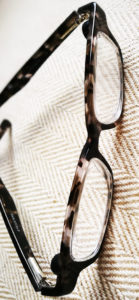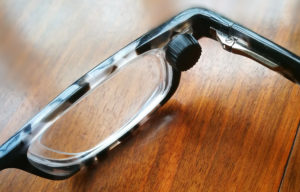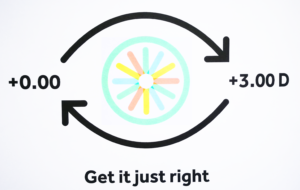You can pick up cheap reading glasses everywhere, where “cheap” is a variable anything upward of 99p. My house is full of them, if only because I need different focal lengths for different tasks. I work about a foot and a half away from my phone, and around two feet away from my laptop screen, and I need different strength glasses just for those two tasks. Threading needles (yes, I seem to have been elected the family sew-person) or soldering up an electrical joint will often have me reaching for a magnifying glass.
A one-size-fits-all pair of glasses would be the ideal solution. Eyejusters claims to be able to deliver just that.

IT HAPPENS TO ALL OF US IN TIME. The human eye is a miraculous construction, with a variable focus crystalline lens that changes its shape under the control of tiny muscles around the perimeter. But as we age—45 is the average turning point—our lenses stiffen and the muscles lose their power. Typically, focussing on a close-up object like a book or a computer screen becomes harder. Eventually we cave in and admit we need glasses.
For some of us with otherwise normal sight a pair of cheap reading glasses will do the job adequately. But if you’re like me, as well as a reader, also a voracious laptop and phone user, and part-time family jewellry repairer, it won’t be long before you realise that squinting through the same pair of Poundland specs for all these different jobs can be—quite literally sometimes—something of a headache.
According to a report last year, more than 60% of us spend at least five hours every day using computers or other technology devices. Young, healthy eyes have evolved to adapt to viewing different kinds of images at different distances under different illumination. Regular reading glasses, with their fixed dioptre settings, can’t do that.
I first came across these ingenious Eyejusters glasses at a trade show where every other item was electronic, with a computer processor at its heart. Naturally I expected the glasses to glow or beep, or otherwise do something clever. They’re certainly clever, but no batteries are involved.
How the Eyejusters work

Earlier attempts to create variable focus glasses have used cumbersome fluid-filled lenses. Six years ago, a company called PixelOptics even introduced game-changing glasses that changed focus using liquid crystals controlled by a built-in rechargeable battery. But delivering a reliable product proved problematic and PixelOptics folded in 2014.
The Eyejusters approach is very much simpler and neater. Each lens is, in fact, a pair of lenses, each one of the pair computer-calibrated to have areas of positive and negative magnification. Two small knurled wheels concealed behind the frame adjust the relative position of each of the pairs, sliding one against the other so that the negative and positive areas compensate or complement one another. This gives each lens pair a range of magnifications between +0 and +3 dioptres.
The strength of each of the lenses can be adjusted independently—Eyejusters calls this “SlideLens™ Capsule Technology”. If each of your eyes needs a slightly different strength this is a useful feature you won’t find in regular off-the-shelf reading glasses. But be aware that only prescription lenses can compensate for more complicated conditions like astigmatism.
You’ll need to develop a technique for changing each of the lenses for different viewing distance. At first, I mourned the absence of any way of setting up presets: click for needle threading, click-click for reading my phone, click-click-click for the laptop screen, and so on. But this, of course, would greatly complicate the elegant mechanism.
 It turns out to be very simple to make the manual adjustment each time. I can close my left eye leaving the right eye open, but not the other way round. So I begin by closing my left eye and tweaking the wheel that controls the right lens. Then I open both eyes and use my right hand to cover my right eye while I adjust the left lens. Within a couple of seconds I have perfect focus. However, when I have a phone in my hand it isn’t so easy. I’m still working on how to do this.
It turns out to be very simple to make the manual adjustment each time. I can close my left eye leaving the right eye open, but not the other way round. So I begin by closing my left eye and tweaking the wheel that controls the right lens. Then I open both eyes and use my right hand to cover my right eye while I adjust the left lens. Within a couple of seconds I have perfect focus. However, when I have a phone in my hand it isn’t so easy. I’m still working on how to do this.
The lenses are untinted and are delivered with an anti-scratch coating. I’ve come across one other current American rival manufacturer of similar, though more utilitarian, glasses, but Eyejusters claims to be the first adjustable glasses to become available in standard frames—the type of frames you would be able to buy in an optician’s.
A variety of different frames are available: the full catalogue is here. You won’t find Eyejusters in Poundland—at around £70 their price is outside the range of even the better-known brand names like Foster Grant (although considerably cheaper than the failed $1,200 PixelOptics). But these UK-manufactured specs are no ordinary reading glasses and they come with a 30-day return warranty and a one-year guarantee.
Chris Bidmead

Dear Sir’s
we have see your nice idea about lenses adjustable, if you don’t have an Italy dealer and or a distributor we can have interest to be italy distributor
Greetings from Torino
Antonio Leone
Thanks, Antonio.
I’m in no way associated with the manufacturer of these glasses, just a reviewer writing on behalf of my readers. But I’ve passed your message on to Eyejusters’ PR company. You should be hearing from them soon—if not, do please get back to me.
Dear Chris thsankl for yor help to passed my request to the PR Company I reain to wait as soon them answer
Have a nice time
Antonio